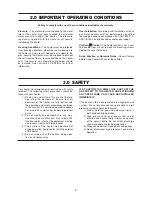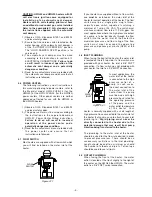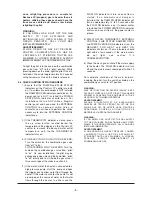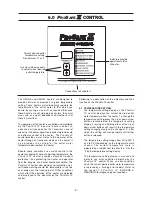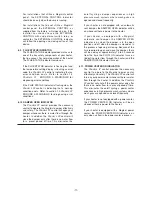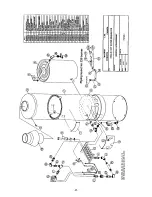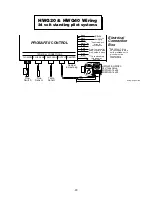
-15-
10.1 COIL CONDENSATION
During the operation of your heater, you may
notice water in the base of the heater or you may
hear the sizzling of water drops falling on the
flames of the main burner. This collection of water
or “dripping” of water is typical in the operation of
all steel coil heaters. It is caused by the products
of gas combustion which produce gaseous carbon
dioxide and water vapour. The water vapour
condenses on the coils which have cold water
running through them. The lower the temperature
of the incoming water, and the higher the rate of
combustion and/or the higher the relative
humidity, the more “drip” that occurs. Over a
period of time this tends to decrease.
If you suspect that the water in the base of the
heater is not from coil condensation, turn the
heater off such that the main burners are not lit
and run water through the heater. The “dripping”
of water from coil condensation will stop after a
short period of time.
10.2 COIL SCALING
Scale build-up in the heater coil can reach a point
where the recovery rate of the heater is reduced
and/or the flow of water through the heater is
restricted. Use of hard water through the heater
tends to accelerate scale build-up. Should scale
build-up reach a point where the operation of the
heater is affected, descaling with an approved coil
cleaner may be required. See section 8.4
CLEANING HEATER COIL OF SCALE for more
information.
10.3 FREEZING CONDITIONS
Freezing conditions can result in severe damage
to the heater coil. Coils must be drained
completely with compressed air or have anti-
freeze run through them if they are exposed to
freezing weather. Note that heater coils installed
in a heated building can still freeze. If the building
has a negative pressure cold air will be drawn
down the chimney and could freeze the top of the
coil. This can normally be prevented by the use of
an automatic vent damper.
10.4 USE OF ACIDS
If acids of any type are used then a form of
downstream chemical injection or suitable check
valve should be used to protect the coil.
10.5 COIL TEST
After manufacture each coil is hydrostatically
pressure tested to 3500 PSI. Each heater also has
a final hydrodynamic leak test performed after
final assembly (with all fittings installed) before the
heater leaves the factory.
10.6 TERMINAL CONNECTIONS TO
P
RO
S
AFE
IIII
Except for the FLOW SW connection, the
P
RO
S
AFE
II
uses lockable polarized plugs for all
it’s terminal connections. To remove a plug you
must press down on the locking pin and then pull
the plug out. Never use excessive force to remove
the plugs. When reinserting a plug, simply align
the plug with the correct terminal connection and
insert. Plugs are polarized and will only fit into the
correct terminal connection.
10.0 HELPFUL INFORMATION
Connections to ProSafe II
Summary of Contents for HWG20
Page 2: ...this page was intentionally left blank...
Page 4: ...this page was intentionally left blank...
Page 23: ...20...
Page 24: ...21...


